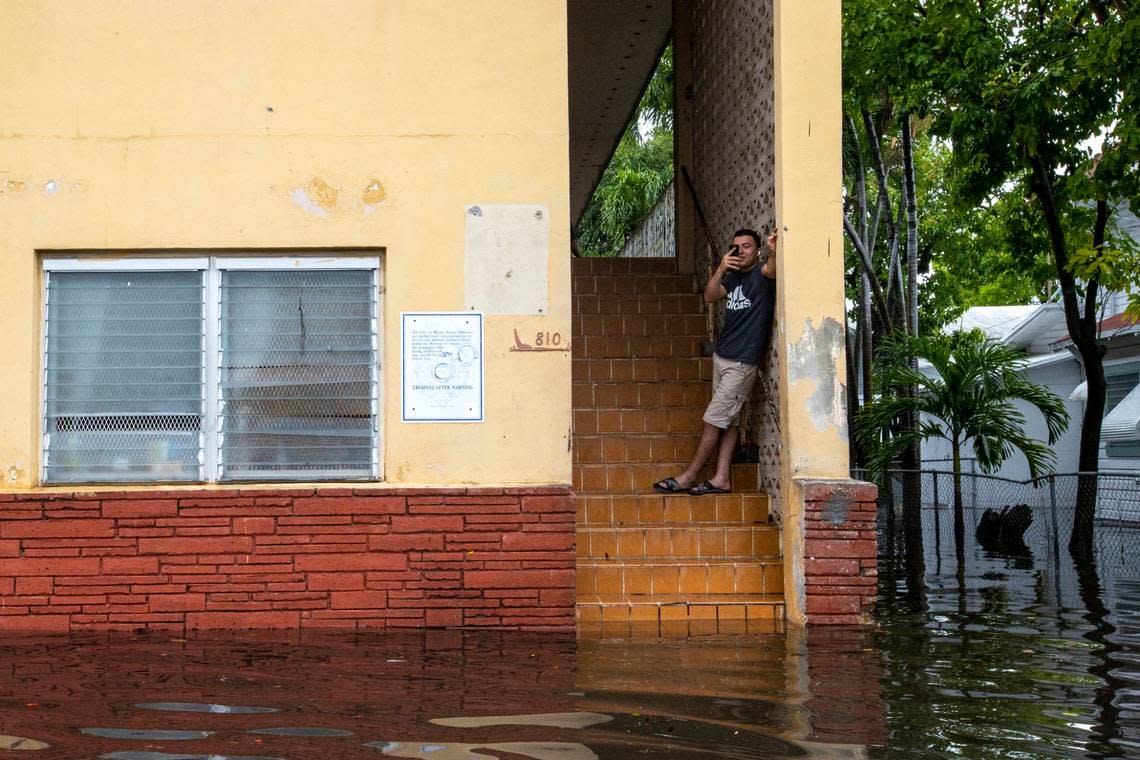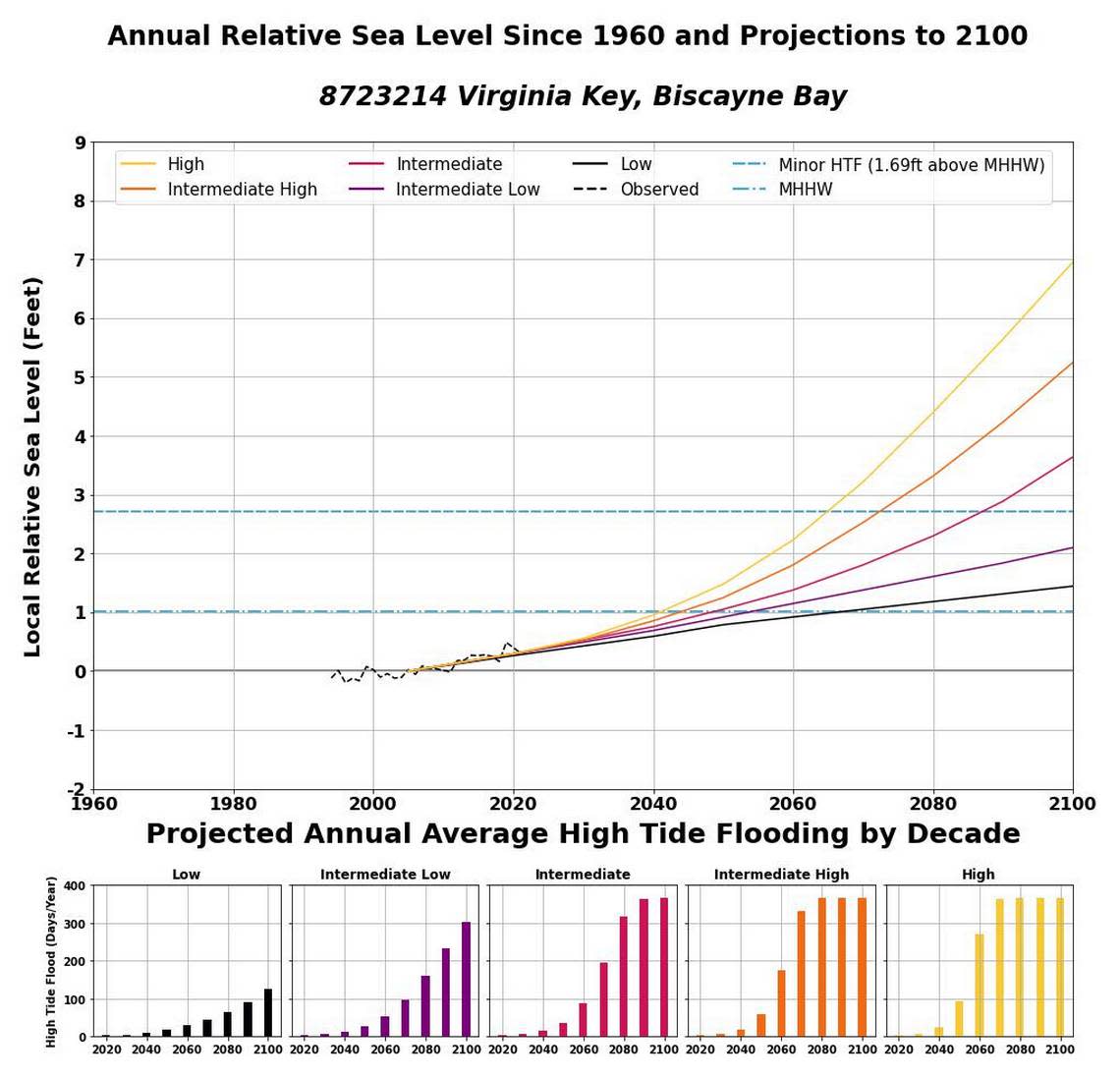Miami had no high tide flooding last year, NOAA says. Thank the ‘moon wobble’
According to NOAA, Miami didn’t have high tide floods at all last year.
That may come as a surprise to anyone living in the low-lying city who found themselves driving through streets with water up to the windows of their cars or saw their docks or sea walls totally submerged.
Last year, NOAA predicted that the Virginia Key tidal gauge could see four to seven high tide flood days between May 2021 and April 2022. It recorded zero.
It’s the same story for Marathon and Key West: zero high tide flood days last year.
That’s not a sign that climate change, which is expected to bring nearly two feet of sea rise to South Florida by 2060, is suddenly not a problem anymore. It just means that NOAA’s definition of a high tide flood isn’t the same as an average Miami resident. The agency’s nationwide standard doesn’t count the lower-level floods that still cause noticeable impacts, something researchers have pointed out for years.
“It does not necessarily mean there wasn’t flooding and weren’t impacts, it just means it didn’t reach a certain depth,” said William Sweet, an oceanographer at NOAA’s Center for Operational Oceanographic Products and Services and lead author of this year’s high tide flooding outlook.
“On a year-over-year basis, it’s accelerating. However, in any given year you may be above or below that trend. That doesn’t mean you’re all of a sudden free from that flood issue.”
Flood of troubles: Why Miami-Dade’s drainage problems won’t be fixed anytime soon
Next year, the NOAA report predicted Miami could see three to six high tide flood days, where the ocean gets around two feet higher than sea level.
The number of high tide floods at Miami’s Virginia Key has been all over the map since NOAA started keeping track of them. In 2018, zero flood days were reported. In 2019, there were nine, a record. In 2020, there were six. In 2021, there were zero again.
Brian McNoldy, a research scientist at the University of Miami, said the Virginia Key tidal gauge was above the ‘minor’ flood threshold at least 11 days since November, including a week in mid-May, but the ‘major’ threshold NOAA used wasn’t crossed last year and hasn’t been crossed yet this year.
The period that NOAA assessed didn’t include the unnamed rainstorm that struck Miami in early June that flooded dozens of homes, spilled tens of thousands of gallons of sewage onto South Florida streets and swamped cars at intersections all over the county.
That flood event was driven more by rain than high tides, so it might not register on next year’s count.
Why should you stop frolicking in Miami-Dade floodwater? It’s probably full of poop
“The tidal flooding threshold is independent of any rainfall-induced flooding, so if there’s just a heavy rain that causes a lot of flooding, that won’t count,” McNoldy wrote in an email.
In the press conference to announce next year’s high tide outlook, Sweet said that the annual high tide flooding across the nation will likely be about the same as last year, thanks to the impacts of several factors, including the “moon wobble.” Scientists found that the moon generally moves closer and further away from the Earth in an 18-year cycle during its orbit. When it’s closer, high tides are generally higher, and when it’s further away, tides are lower.
“Right now we’re sort of on a downswing nearing the bottom of the peak. And then it’s expected to swing upwards,” Sweet said.
That could mean high tides are as much as half a foot higher in the next few years, he said. For the highest tides of the year, King Tides, that could make a big difference in low-lying places like Miami.

“At this point, inches matter in terms of flooding,” Sweet said.
Another factor holding the number of high tide flood days lower nationwide is a weather phenomenon known as La Nina. It’s generally linked to more Atlantic hurricanes, but lower sea levels on the Pacific coast of the U.S.
“There’s a few things working in our favor right now. But we do not expect that trend to continue,” Sweet said.
On the contrary, NOAA expects far more flooding in South Florida’s future.
By 2050, NOAA predicted that Miami could see 35 to 60 days of high tide flooding. That’s a jump from last year’s 2050 prediction of 10 to 55 days, likely a nod to the brand new sea level rise curves the agency released earlier this year. The 2022 projections show — strangely — less sea level rise in the next few decades, but similar amounts toward the end of the century.
Under NOAA’s intermediate sea level rise projections, which is the standard for South Florida governments, Miami could see high tide flooding almost every single day of the year by 2090, a sign that our current standard for high tide flooding could become the everyday high tide.

